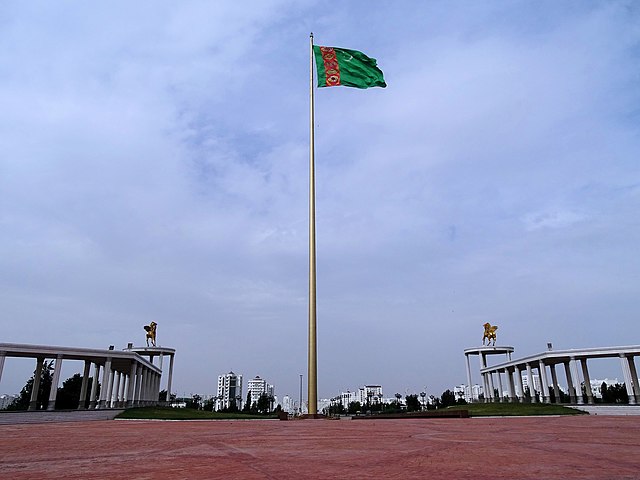Only flag in Asia without red, green or white on it! - Kazakhstan
Kazakhstan’s flag is extremely unique in its beautiful colours
of sky blue/teal and amazing bright gold. It also happens to be one of 6 in the world that doesn’t feature red, green or white. More incredibly it’s the only flag in all of Asia without any of these 3 colours.
The ornamental pattern down the left-hand side of the flag is called “koshkar muiz” which means “the horns of the ram”, and represents the art and cultural traditions of the Kazakh people. This pattern is all over Kazakhstan, used in construction and interior design, it’s used in menus and on clothing, and really is just all over the place. If you go to Kazakhstan and keep your eyes open you’ll definitely see this design.
The steppe eagle which makes up part of the central design is a symbol that has appeared on tribal flags for centuries and represents freedom and power. The sun which rests atop the eagle, has 32 rays that are in the shape of grains of wheat, which ironically (given the huge expanse of Kazakhstan that is completely barren desert) is supposed to represent the prosperity of the land.
Blue representing water when the country is doubly landlocked! – Uzbekistan
The blue on the flag of Uzbekistan is said to represent water,
which we find particularly strange considering Uzbekistan isn’t just a landlocked country, but is in fact one of only 2 double landlocked countries in the world, the other being Liechtenstein. Of course they do have water in Uzbekistan and it does occasionally rain, although not much considering how hot and dry it is, however it is strange to have water as a focus when not being anywhere near the sea.
Although the country’s relationship with Islam, and religion in general for that matter, is a bit complicated, there is a nod to their Islamic history in the top left-hand corner of the flag. As with flags of many Islamic countries, there’s a crescent moon, and next to it lies twelve stars to represent the months of the Islamic calendar and the signs of the Zodiac.
Although this is possibly the least unique flag of Central Asia (well it certainly isn't the most unique!), they are extremely proud of it, and it appears prolifically all around Uzbekistan. The blue/white/green tricolour appears on doorways, electricity poles, advertising, company logos and much more. Whilst in Uzbekistan, at any point it will almost certainly be that you can see a representation of the flag, or at least the tricolour.
There was a funny little hiccough in 2010 when the First President Islam Karimov (who died in 2016) decided that this was inappropriate usage of the national flag, and made it illegal to use the flag for anything other than direct government business. This did minimise the use of it somewhat, but gradually since then most things that had been removed or painted over have been replaced or re-painted.
Only flag with a carpet on it! - Turkmenistan
Which is the only flag in the world with pictures of carpets
on it? You got it – Turkmenistan! Carpets are a pretty big deal in Turkmenistan. They're very proud of their prosperous carpet industry and pictures of carpets are found everywhere – posters, signposts, petrol stations, book covers, even vending machines. The carpet museum in Ashgabat is one of the most expensive attractions in the whole country and the government holds an annual festival that is devoted entirely to carpets. Every official event has Turkmen carpets covering the floors and lining the walls, and most pictures of the President (except when he’s outside with horses and dogs) have him in front of an iconic Turkmen carpet.
The five carpets that run down the left-hand side of the flag represent the five tribes of Turkmenistan. The crossed olive branches at the bottom of the carpet motif, similar to the one found on the UN flag, symbolises Turkmenistan's “status of permanent neutrality”.
Only flag with a yurt on it! - Kyrgyzstan
The yellow circle with a cross in the centre of the flag is in fact
the shape that is found at the top of every yurt, called a tunduk, and is iconic in the design of them. This isn’t the only place in Kyrgyzstan that you’ll see this design either – people have them built into their fences, painted on walls, used as logos for business, and much more.
Yurts are somewhere between permanent tents and temporary houses, and are the homes that nomadic people, of which there are still many in Kyrgyzstan, live. They are made by draping layers and layers of hand-made felt over a wooden frame, forming a sort of tee-pee shape. They're really easy to assemble and disassemble (within the context of them being houses) and are literally picked up and moved when need be. In the context of a tent though they’re pretty time consuming and difficult to put up!
The sunrays around the tunduk in the centre aren’t just any old sunrays either – there are specifically 40 of them, representing the 40 tribes that were united by their national hero, Manas, to fight against Genghis Khan and the Mongols.
The only Soviet republic with a 2 sided flag! - Tajikistan
While the current flag of Tajikistan is very cool, representing its Persian and Tajik heritage, it is a tricolour of red, green and white, with a crown in the middle. Not great for a unique fact. A great fact about the former flag of the Tajik Soviet Socialist Republic is that it was the only Soviet republic with a 2 sided flag. The front side contained a hammer and sickle like all republic flags of the Soviet Union, however the reverse side did not contain the hammer and sickle.



